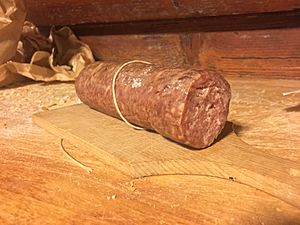Ciauscolo facts for kids
Ciauscolo (say "chow-skoh-loh") is a special type of Italian sausage. It's a bit like salami, but it's very soft! This tasty food comes from the Marche region in Italy. You can also find it in nearby Umbria.
Contents
What is Ciauscolo?
Ciauscolo is a unique kind of sausage. It is known for being so soft that you can spread it like a pâté or soft cheese. This makes it different from most other firm sausages.
How is Ciauscolo Made?
Making Ciauscolo is a special process that gives it its unique texture and flavor.
Ingredients and Mixing
Ciauscolo starts with pork meat and fat. The meat comes from the pork's shoulder and belly. These parts are chosen for their flavor and texture. The meat and fat are ground very, very finely. Then, they are mixed with spices like black pepper and garlic. A little white wine is also added to the mix.
Stuffing and Drying
After mixing, the meat is put into wide natural casings. These are like the "skin" of the sausage. The sausages are then left to dry for about 12 to 24 hours. This first drying step helps the outside of the sausage become a bit sticky.
Smoking and Curing
Once the surface is ready, the Ciauscolo sausages are cold-smoked. This means they are smoked at a low temperature. They are smoked over juniper branches for two days. This smoking gives the sausage a nice, smoky flavor. After smoking, the sausages are hung up to cure. Curing is a process where the sausage ages and develops its full flavor.
How Long Does it Take?
Even though Ciauscolo can be aged for a month or more, it is often eaten after just two weeks. This shorter aging time helps keep it very soft and moist. The result is a delicious sausage that you can easily spread on bread!
Special Recognition
Ciauscolo is so special that it received a "Protected Geographical Indication" (PGI) status in 2009. This means that only sausages made in a specific way and in certain areas of Italy can be called Ciauscolo. It helps protect the traditional way of making this unique food.
Other Types of Ciauscolo
In some parts of Marche, there's a different version called ciauscolo di fegato. This type uses some pork liver instead of just fat. The liver makes the sausage darker and gives it a stronger flavor. This variant also includes different spices like orange zest and fennel flowers.
Where Does the Name Come From?
The word ciauscolo is linked to a local dialect word, ciausculu. It's not clear which word came first. One idea is that ciauscolo comes from the old Latin word cibusculum. This word means "small food."


